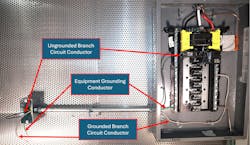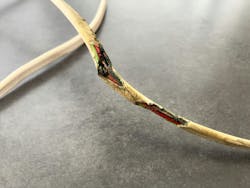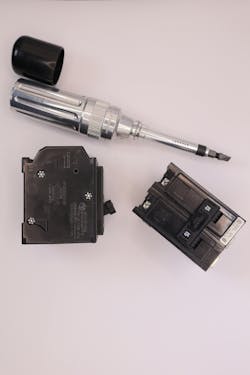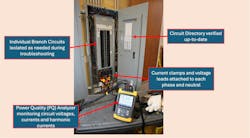Branch circuits are undoubtedly the most commonly installed circuits in both residential and non-residential applications. And, since they supply the equipment that utilizes the electricity, they are often in the limelight when it comes to trouble calls. Rarely is it a problem with the branch-circuit wiring itself. The cause is usually found at the end of the branch circuit — the load. In some cases, it could be other branch circuits causing misoperation of one circuit. This article first examines the National Electrical Code (NEC) definition of the branch circuit. Then, three of the most common trouble calls associated with branch circuits are explored. Finally, maintenance requirements are discussed.
The branch circuit
A branch circuit is defined in the NEC as the conductors that run from the final overcurrent protective device in a circuit to the outlet (Fig. 1). Note that this does not include the overcurrent protective device (OCPD) — typically the fuse or circuit breaker supplying the branch circuit — nor does it include the outlet device itself. The branch circuit is the conductors only. However, for troubleshooting and maintenance, it is practical to discuss the OCPD and the load supplied.
Following are three of the most common problems with branch circuits and tips on how to solve them.
1. No power
This first one seems simple. No power — turn the breaker back on! But consider that the purpose of the OCPD is to prevent a fire. So, resetting and turning a breaker back on — or replacing fuses on a fault with excessive current flow — does not make sense. In fact, both OSHA Part 1910 Subpart S and the NFPA 70E, Standard for Electrical Safety in the Workplace, prohibit closing a circuit breaker or replacing circuit fuses until it is known that the circuit can be safely reenergized.
Therefore, finding the cause of the overcurrent device operation is the first step in solving the problem. A walk-through of the circuit may reveal the obvious. The smell of burnt insulation or discoloration on enclosures is definitely a suspect item (Photo 1).
Checking for trips on ground-fault circuit interrupters (GFCIs) and arc-fault circuit interrupters (AFCIs) may help to pinpoint issues. For GFCI trips, look for faulted equipment or the presence of water or moisture around equipment. Tripping of AFCIs may indicate a problem with the branch-circuit conductors themselves. The breakdown of older insulation or the nail driven through the wall that nicks a wire may be the cause. Unfortunately, the AFCI trips may not be the easiest to find or repair. Depending on building age, arc-fault and ground-fault devices may not be installed per the current Code requirements (see Sidebar on page 30, “Keeping Branch Circuits NEC Compliant”). Expanded requirements for GFCIs did not appear in the Code until the 1970s. AFCI requirements first appeared in 1999, and the number of circuits requiring such protection has increased over the Code cycles.
If a visual inspection does not reveal the obvious, meter testing is necessary to determine the cause of the trip. You must understand the circuit to troubleshoot effectively. Know your test equipment and its limitations. Short circuits are characterized by instantaneous OCPD operation caused by very low resistance between conductors. Yet, motor windings will typically measure a very low-resistance value as they are just coils of wire.
Low readings with a digital multimeter (DMM) may not always be an indication of a short circuit — a more accurate low-resistance ohmmeter may be needed. With no loads attached to the branch circuit, you should read infinite resistance between the ungrounded conductor(s) and the neutral or the equipment-grounding conductor (EGC). Also, make sure you are not checking for shorts and ground faults through parallel circuits.
Following a logical and sequential set of steps is the best method for any type of troubleshooting. The most likely cause of OCPD operation is a short circuit, ground fault, or overload. Rarely is it a faulty circuit breaker. A short circuit or ground-fault condition can be expected to trip a breaker instantaneously, while an overload may take from seconds to minutes to cause OCPD operation.
If an overload is suspected, use a clamp-on ammeter to measure current flow on branch-circuit conductors while following all safety precautions for testing and measuring energized circuits. Record the amount of current that flows in the circuit. If possible, use test equipment that will record the data, since overloads may take some time to occur. Compare readings to nameplate data and manufacturer’s instructions.
Isolating short circuits and ground faults may require additional test equipment beyond the DMM. A panelboard may require being put into an electrically safe work condition. It is generally best to begin at the source of the branch circuit — the load side of the OCPD.
Test for ground faults using a megohmmeter. Disconnect any electronics that could be damaged by the higher voltage output of the megohmmeter. Test each ungrounded conductor from phase to ground. If any reading is less than 1 megohm, disconnect the load, and test the branch circuit and the load individually to isolate the ground fault (Fig. 2).
2. Intermittent troubles
Typical trouble calls: “Every once in a while, the breaker trips, and we don’t know why.” Or “Sometimes, the equipment works, and sometimes it doesn’t.” If overload conditions have been eliminated, next suspect something that can cause intermittent problems — loose terminal connections.
Faulty terminal connections can be loose, causing voltage issues. They may eventually overheat, resulting in catastrophic failure. Make sure all terminations are tightened to their specified torque values.
Improperly tightened terminals continue to be an issue with all electrical installations. It is tempting to just “tighten up all those terminal screws.” But, if not done properly, more issues may be created. Loose terminal connections increase resistance and can cause erratic equipment operation. Applying too much torque can strip threads, distort terminals, damage the conductor, and increase resistance. Small increases in resistance values make for proportionately much larger increases in heat.
NEC Sec. 110.14(D) [Terminal Connection Torque] states, “Tightening torque values for terminal connections shall be as indicated on equipment or in installation instructions provided by the manufacturer. An approved means shall be used to achieve the indicated torque value.” Comply with the Code, follow manufacturers’ instructions, and use an approved method to verify termination torque and prevent branch-circuit overheating. See Photo 2 for one common method to verify proper torque on branch-circuit OCPDs and outlet devices — the torque screwdriver.
3. The not-so-obvious power quality problems
If overheating and OCPD operation continue to exist, consider power quality problems. Power quality issues can be easily overlooked. Many contractors and facility maintenance staff do not have power quality analyzers to troubleshoot these problems. Personnel may not be adequately trained to measure and analyze such branch-circuit problems.
Power quality problems on branch circuits include nonlinear loads that operate either on the branch circuit or elsewhere in the distribution system. Nonlinear loads are loads that rectify AC incoming power to provide DC to the circuit. Examples are computers, printers, variable-speed drives, UPS systems, and LED lighting. These loads produce harmonic currents that cause overheating in branch circuits and distort the 60-hertz sine wave, causing equipment to not operate properly. Voltage sags and swells in the distribution system may cause misoperation of loads on the branch circuit.
Power quality analysis may well isolate the problems of tripping circuit breakers when no other apparent cause can be found (Fig. 3). Additionally, monitoring and analyzing power quality in commercial and industrial branch circuits uncovers those sometimes-unexplainable problems: Why does the breaker only trip around 2 a.m. on certain nights? What causes the VFD to trip on overvoltage when the circuit voltage is well within specifications? Consider power quality!
Maintenance requirements
The NFPA 70B, Standard for Electrical Equipment Maintenance, does not address branch circuits specifically. However, it does provide maintenance and testing requirements for what is at either end of the branch circuit — the overcurrent protective devices, outlet devices, and various loads. By maintaining the equipment and devices protecting the branch and the devices and loads supplied, the integrity of the branch circuit is maintained. Given time, all electrical equipment degrades and will fail. Heating and cooling from current flow causes expansion and contraction of components within devices and equipment. Terminals will loosen.
To maintain branch-circuit components, first determine which branch circuits are to receive regular maintenance and what testing is to be performed. NFPA 70B provides the requirements to select circuits and determine their required maintenance frequency. It then lists the required maintenance items and tests to be performed. Use this standard to include branch circuits in a maintenance program.
Summary
A branch circuit that fails to operate properly is sure to result in trouble calls. Many problems can be isolated to one of three common causes: short circuits, ground faults, or overloads. Understanding their symptoms — and how to troubleshoot and isolate them — is the job of the electrical professional. Complying with Code requirements and combining effective troubleshooting with good maintenance practices results in less downtime and a safer installation.
Keeping Branch Circuits NEC Compliant
While requirements for branch circuits are found throughout the National Electrical Code (NEC), below are some Code sections to help ensure compliance:
110.7: Use the proper test equipment once branch circuits are installed or repaired to verify they are free from short circuits and ground faults.
110.8: Watch for DIYer ‘s who may have become creative! Make sure only NEC wiring methods are used for branch circuit installation or modifications.
110.12:Be the professional! Make sure all work is completed in a “professional and skillful manner.” Close unused openings as specified in the NEC. Refer to the NECA 1-2015, Standard for Good Workmanship in Electrical Construction and other standards as needed.
110.14: Follow all requirements for terminals, splices, temperature limitations of terminals, and terminal connection torque
110.17: Ensure only qualified persons, (see NEC Article 100 definition), service and maintain branch circuits and all electrical systems and equipment. Follow any manufacturers’ instructions and use identified replacement parts.
110.22: Make sure all branch-circuit disconnecting means are properly identified per the Code.
210.5: When replacing conductors or modifying a branch circuit ensure all conductors are properly identified.
210.8: There are 6 subsections to 210.8 covering several different applications of GFCIs. Verify GFCI protection is provided in all required locations.
210.12: Verify AFCI protection in all required locations and by the proper methods specified in this section.
408.4(A): Provide a legible and permanent description of every circuit. For panelboards, this is the circuit directory located in, on, or adjacent to the panelboard. For switches and larger circuit breakers the description must be at each switch or breaker.
About the Author

Randy Barnett
CESCP
Randy Barnett is an NFPA Certified Electrical Safety Professional, a long-time journeyman electrician, instructor and author with expertise in industrial electrical construction and maintenance. He is Electrical Codes & Safety Manager for NTT Training. Because of his ability to develop and deliver quality programs, Randy has trained more than 10,000 students in all 50 states, including Canada, Singapore, Afghanistan, Dubai, Trinidad, and Saudi Arabi. His articles appear in numerous trade publications and, his book on "Commercial and Industrial Wiring" is used as an entry-level text in many electrician training programs. Randy also appears at various corporate and trade association speaking engagements and consults on training program design and implementation. Randy is a graduate of the U.S. Navy Nuclear Power School, served as a nuclear electrician in submarines and holds a B.S. in business.





